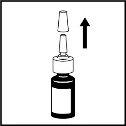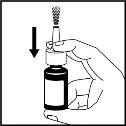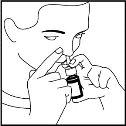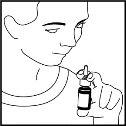
LASTIFLUNO 137/50 micrograms nasal spray suspension
Ask a doctor about a prescription for LASTIFLUNO 137/50 micrograms nasal spray suspension

How to use LASTIFLUNO 137/50 micrograms nasal spray suspension
Introduction
Package Leaflet: Information for the Patient
Lastifluno 137 micrograms/50 micrograms/dose,
nasal spray suspension
azelastine hydrochloride / fluticasone propionate
Read the package leaflet carefully before you start using this medicine because it contains important information for you.
- Keep this package leaflet, you may need to read it again.
- If you have any further questions, ask your doctor or pharmacist.
- This medicine has been prescribed for you only. Do not pass it on to others. It may harm them, even if their signs of illness are the same as yours.
- If you experience any side effects, talk to your doctor or pharmacist. This includes any possible side effects not listed in this package leaflet. See section 4.
Contents of the package leaflet
- What is Lastifluno and what is it used for
- What you need to know before you use Lastifluno
- How to use Lastifluno
- Possible side effects
- Storage of Lastifluno
- Contents of the pack and other information
1. What is Lastifluno and what is it used for
Lastifluno contains two active substances: azelastine hydrochloride and fluticasone propionate.
- Azelastine hydrochloride belongs to a group of medicines called antihistamines. Antihistamines work by preventing the effects of substances such as histamine, which is produced by the body as part of an allergic reaction; in this way, it reduces the symptoms of allergic rhinitis.
- Fluticasone propionate belongs to a group of medicines called corticosteroids, which reduce inflammation.
Lastifluno is used to relieve the symptoms of moderate to severe seasonal allergic rhinitis and perennial allergic rhinitis, if treatment with an antihistamine or intranasal corticosteroid alone is considered insufficient.
Seasonal or perennial allergic rhinitis are allergic reactions to substances such as pollen (hay fever), house dust mites, molds, dust, or domestic animals.
Lastifluno relieves the symptoms of allergies, such as: runny nose, postnasal drip, sneezing, itching, or nasal congestion.
2. What you need to know before you use Lastifluno
Do not use Lastifluno
- If you are allergic to azelastine hydrochloride or fluticasone propionate, or to any of the other ingredients of this medicine (listed in section 6).
Warnings and precautions
Talk to your doctor or pharmacist before starting to use Lastifluno if:
- You have recently had an operation or injury to your nose or mouth.
- You have a nasal infection. Nasal infections should be treated with antibacterials or antifungals. If you have been given medication for a nasal infection, you can continue using Lastifluno to treat your allergy.
- You have tuberculosis or an untreated infection.
- You have changes in vision or a history of elevated intraocular pressure, glaucoma, and/or cataracts. If you have any of these diseases, you will be closely monitored during the use of Lastifluno.
- You have impaired adrenal function. Caution should be exercised when switching from systemic steroid treatment to Lastifluno.
- You have severe liver disease. The risk of systemic adverse effects will increase.
In these cases, your doctor will decide if you can use Lastifluno.
It is important that you take the dose indicated in section 3 or the dose indicated by your doctor. Treatment with higher doses of corticosteroids than recommended may lead to adrenal suppression, which can cause weight loss, fatigue, muscle weakness, low blood sugar levels, need for salt, joint pain, depression, and skin darkening. If you experience any of these side effects, your doctor may recommend another medication during periods of stress or elective surgery.
To avoid adrenal suppression, your doctor will advise you to take the lowest dose that maintains effective control of your rhinitis symptoms.
The use of nasal corticosteroids (such as Lastifluno) may cause slower growth in children and adolescents when used for a long time. The doctor will regularly check the growth of children and ensure that they take the lowest effective dose possible.
Contact your doctor if you experience blurred vision or other visual disturbances.
If you are not sure if you are in any of the above situations, consult your doctor or pharmacist before using Lastifluno.
Children
This medicine is not recommended for use in children under 12 years of age.
Using Lastifluno with other medicines
Tell your doctor or pharmacist if you are taking, have recently taken, or might take any other medicines, including those obtained without a prescription.
Some medicines may increase the effects of Lastifluno, so your doctor will closely monitor you if you are taking these medicines (including some for HIV: ritonavir, cobicistat, and medicines for the treatment of fungal infections: ketoconazole). Do not use Lastifluno if you are taking sedative medicines or those that affect the central nervous system.
Pregnancy and breastfeeding
If you are pregnant or breastfeeding, think you may be pregnant, or are planning to have a baby, ask your doctor or pharmacist for advice before using this medicine.
Driving and using machines
Lastifluno has a minimal influence on the ability to drive and use machines.
Very rarely, you may experience fatigue, weakness, or dizziness due to the disease itself or during the use of Lastifluno. In these cases, do not drive or operate machinery. Note that alcohol consumption can enhance these effects.
Lastifluno contains benzalkonium chloride.
This medicine contains 14 micrograms of benzalkonium chloride in each spray.
Benzalkonium chloride may cause irritation or inflammation inside the nose, especially when used for long periods of treatment.
Tell your doctor or pharmacist if you notice discomfort when using the spray.
3. How to use Lastifluno
Follow the instructions for administration of this medicine exactly as indicated by your doctor. If you are unsure, consult your doctor or pharmacist again.
It is essential that the use of Lastifluno is regular for the therapeutic benefit to be complete.
Avoid contact with the eyes.
Adults and adolescents (over 12 years of age)
- The recommended dose is one spray in each nostril, in the morning and in the evening.
Use in children under 12 years of age
- This medicine is not recommended for use in children under 12 years of age.
Use in case of renal and hepatic insufficiency
- There are no data available in patients with renal and hepatic insufficiency.
Method of administration
Nasal route.
Read the following instructions carefully and use the product only as indicated.
INSTRUCTIONS FOR USE
Preparing the spray
- Gently shake the bottle for 5 seconds, tilting it from top to bottom, and then remove the protective cap (see Figure 1).
Figure 1

- The first time you use the nasal spray, you need to prime the pump by spraying into the air.
- Prime the pump by placing two fingers on either side of the spray pump and placing your thumb on the base of the bottle.
- Pump and release the pump 6 times, until a fine spray appears (see Figure 2).
- Now, the pump is primed and ready to use.
Figure 2

- If you have not used the nasal spray for more than 7 days, you will need to re-prime the pump by pressing and releasing it. Gently shake the bottle for 5 seconds, tilting it from top to bottom, and then remove the protective cap (see Figure 1) and press and release the pump once.
Using the spray
- Gently shake the bottle for 5 seconds, tilting it from top to bottom, and then remove the protective cap (see Figure 1).
- Blow your nose to clear your nostrils.
- Keep your head tilted forward. Do not tilt your head back.
- Keep the bottle upright and carefully insert the tip of the spray into one nostril.
- Close the other nostril with your finger, pump the spray once, and at the same time, breathe in gently (see Figure 3).
- Breathe through your mouth.
Figure 3

- Repeat the operation in the other nostril.
- Breathe gently and do not tilt your head back after application. This will prevent the medicine from reaching your throat, causing an unpleasant taste (see Figure 4).
Figure 4

- After each use, clean the tip of the spray with a tissue or a clean cloth, and replace the protective cap.
- Do not pinch the nozzle if you do not get a spray. Clean the valve with water.
It is important that you use the dose prescribed by your doctor. Use only the amount that your doctor has recommended.
Duration of treatment
Lastifluno is suitable for prolonged use. The duration of treatment corresponds to the period during which you experience allergic symptoms.
If you use more Lastifluno than you should
If you apply more of this medicine to your nose than you should, it is unlikely that you will have any problems. If you are unsure or have used a higher dose than recommended for a long time, consult your doctor. If a person, especially a child, accidentally drinks Lastifluno, consult your doctor immediately or go to the nearest medical center, or call the Toxicology Information Service. Phone (91) 562 04 20, indicating the medicine and the amount ingested.
If you forget to use Lastifluno
Use the nasal spray as soon as you remember and then take the next dose at the usual time. Do not take a double dose to make up for forgotten doses.
If you stop using Lastifluno
Do not stop treatment without consulting your doctor, as this may put the success of your treatment at risk.
If you have any further questions about the use of this medicine, ask your doctor or pharmacist.
4. Possible side effects
Like all medicines, this medicine can cause side effects, although not everybody gets them.
Very common side effects (may affect more than 1 in 10 people):
- Nasal bleeding.
Common side effects (may affect up to 1 in 10 people):
- Headache.
- Bitter taste in the mouth, especially if you tilt your head back during the use of the nasal spray. This taste should disappear if you drink a soft drink a few minutes after using this medicine.
- Unpleasant smell.
Uncommon side effects (may affect up to 1 in 100 people):
- Mild irritation of the inside of the nose, which can cause mild itching, tingling, or sneezing.
- Nasal dryness, cough, throat dryness, or throat irritation.
Rare side effects (may affect up to 1 in 1,000 people):
- Dry mouth.
Very rare side effects (may affect up to 1 in 10,000 people):
- Dizziness or drowsiness.
- Cataracts, glaucoma, or increased pressure in the eye, with possible loss of vision and/or redness and eye pain. These side effects have been observed with prolonged treatment with nasal sprays of fluticasone propionate.
- Skin and mucous membrane lesions of the nose.
- Feeling of discomfort, fatigue, exhaustion, or weakness.
- Rash, redness, or itching of the skin, hives.
- Bronchospasm (narrowing of the airways in the lungs).
Seek immediate medical attention if you develop any of the following symptoms:
- Swelling of the face, lips, tongue, or throat, which may make swallowing or breathing difficult, and sudden appearance of a rash on the skin. These could be signs of a severe allergic reaction. Note that this is very rare.
Side effects with unknown frequency (frequency cannot be estimated from the available data)
- Blurred vision
- Nasal ulcers
When this medicine is administered at high doses for a prolonged period, systemic side effects (side effects that affect the whole body) may occur. The likelihood of these effects is much lower if a nasal corticosteroid is used instead of oral corticosteroids. These effects may vary between individual patients and between different corticosteroid preparations (see section 2).
Corticosteroids may affect the normal production of hormones in your body, especially if they are used at high doses for a long time. In children and adolescents, this side effect may cause slower growth.
In rare cases, a reduction in bone density (osteoporosis) may occur when corticosteroids are administered nasally for a long period.
Reporting of side effects
If you experience any side effects, talk to your doctor or pharmacist. This includes any possible side effects not listed in this package leaflet. You can also report side effects directly through the Spanish Pharmacovigilance System for Human Use Medicines: https://www.notificaram.es. By reporting side effects, you can help provide more information on the safety of this medicine.
5. Storage of Lastifluno
Keep this medicine out of the sight and reach of children.
Do not use this medicine after the expiry date which is stated on the label of the bottle and on the carton after “EXP”. The expiry date is the last day of the month stated.
Do not refrigerate or freeze.
Shelf life after opening: Discard any unused medicine 6 months after opening the nasal spray for the first time.
Medicines should not be disposed of via wastewater or household waste. Ask your pharmacist how to dispose of medicines no longer required. These measures will help protect the environment.
6. Contents of the pack and other information
Composition of Lastifluno
The active substances are: azelastine hydrochloride and fluticasone propionate.
Each ml of suspension contains 1,000 micrograms of azelastine hydrochloride and 365 micrograms of fluticasone propionate.
Each spray (0.14 g) delivers 137 micrograms of azelastine hydrochloride (equivalent to 125 micrograms of azelastine) and 50 micrograms of fluticasone propionate.
The other ingredients are: disodium edetate, glycerol (E422), microcrystalline cellulose, sodium carmellose, polysorbate 80, benzalkonium chloride, phenylethyl alcohol, and water for injections.
Appearance of the product and contents of the pack
Lastifluno is a white nasal spray suspension presented in a 25 ml amber glass bottle with a spray pump, an applicator, and a protective cap.
Each bottle of 25 ml contains 23 g of nasal spray suspension (at least 120 sprays).
Each pack contains 1 bottle with 23 g of nasal spray suspension or multiple packs containing 3 bottles, each containing 23 g of nasal spray suspension.
Not all pack sizes may be marketed.
Marketing authorisation holder
Day Zero ehf.
Reykjavikurvegi, 62
Hafnarfjoerdur 220
Iceland
Manufacturer
Teva Czech Industries s.r.o.
Ostravska 305/29
747 70 Opava - Komárov,
Czech Republic
Date of last revision of this package leaflet:
September 2023
Detailed information on this medicine is available on the website of the Spanish Agency for Medicines and Health Products (AEMPS) (http://www.aemps.gob.es/).
- Country of registration
- Active substance
- Prescription requiredYes
- Manufacturer
- This information is for reference only and does not constitute medical advice. Always consult a licensed doctor before taking any medication. Oladoctor is not responsible for medical decisions based on this content.
- Alternatives to LASTIFLUNO 137/50 micrograms nasal spray suspensionDosage form: NASAL PRODUCT, 137 micrograms/50 micrograms/applicationActive substance: fluticasone, combinationsManufacturer: Laboratorios Cinfa S.A.Prescription requiredDosage form: NASAL PRODUCT, 137 micrograms/50 micrograms/actuationActive substance: fluticasone, combinationsManufacturer: Teva B.V.Prescription requiredDosage form: NASAL PRODUCT, 137 micrograms/50 micrograms/applicationActive substance: fluticasone, combinationsManufacturer: Especialidades Farmaceuticas Centrum S.A.Prescription required
Alternatives to LASTIFLUNO 137/50 micrograms nasal spray suspension in other countries
The best alternatives with the same active ingredient and therapeutic effect.
Alternative to LASTIFLUNO 137/50 micrograms nasal spray suspension in Polska
Alternative to LASTIFLUNO 137/50 micrograms nasal spray suspension in Ukraina
Online doctors for LASTIFLUNO 137/50 micrograms nasal spray suspension
Discuss dosage, side effects, interactions, contraindications, and prescription renewal for LASTIFLUNO 137/50 micrograms nasal spray suspension – subject to medical assessment and local rules.







